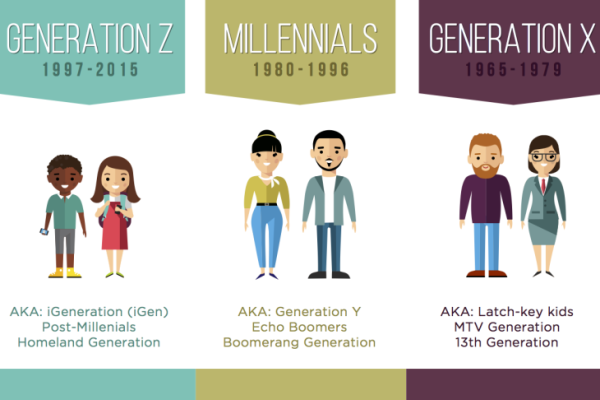The generation that is quickly occupying the majority of business leadership roles is one that’s grown up playing video games, spends the most time shopping online, and uses social media more habitually than any other generation.
If you were thinking it’s millennials, that’s probably because they’ve dominated the media’s focus for the past decade. But it’s actually Generation X, which covers those born between 1965 and 1981 by our definition.
As Pew Research unflatteringly referred to them in a 2014 report, Gen X is “America’s neglected ‘middle child,'” and we don’t hear much about the group. It seems that all eyes are on the slowly retiring baby boomers or the ascending millennials, now the world’s majority generation. But our recent study revealed that Gen X is playing a critical — and underappreciated — role in leadership as organizations grapple with digital transformation.
In our Global Leadership Forecast 2018 — published by DDI, The Conference Board and EY with support from CNBC — we took a look at more than 25,000 leaders spanning 54 countries and 26 major industry sectors. We found that Gen X now accounts for 51 percent of leadership roles globally. With an average of 20 years of workplace experience, they are primed to quickly assume nearly all top executive roles.
Our research revealed that, although they aren’t typically considered digital natives to the extent that millennials are, Gen X leaders are just as likely to be comfortable leveraging technology in the workplace: Some 54 percent of Gen X and 56 percent of millennials reported that they are digitally savvy.
That finding is backed up by research by Nielsen, which revealed that Gen X is the most connected generation. Nielsen found that Gen Xers use social media 40 minutes more each week than millennials. They were also more likely than millennials to stay on their phones at the dinner table and spend more time on every type of device — phone, computer, or tablet. And, as it turns out, Gen X is bringing this connectivity to work.
While Gen X may be equally capable at digital tasks as millennials, they also show a mastery of conventional leadership skills more on par with leaders of the baby boomer generation. That includes identifying and developing new talent at their organizations and driving the execution of business strategies to bring new ideas to reality.
Sixty-seven percent of Gen X leaders are also effective in “hyper-collaboration,” and are working relentlessly to break down organizational silos. Gen X leaders’ strength for working with and through others is enabling them to shape the future of work and generate faster innovation by getting people working together to solve customers’ and their organization’s issues.
Despite their growing influence and responsibilities at work, Gen Xers are most overlooked for promotion and have been the slowest to advance. We found Gen X leaders on average had only 1.2 promotions in the past 5 years, significantly lower than their younger millennial counterparts (1.6 promotions) and more senior baby boomers (1.4 promotions) during the same period of time.
While Gen X leaders are often under-recognized for the critical role they play in leadership, they are typically expected to take on heavy workloads. On average, Gen X leaders have 7 direct reports, compared to only 5 direct reports for millennials. While their advancement rate is slower and their teams larger, Gen X remain loyal employees. Only 37 percent contemplate leaving to advance their careers — five percentage points lower than millennials.
Demonstrating loyalty, a willingness to take on a heavy workload, and a powerful combination of digital and traditional leadership skills, Gen X is producing highly capable leaders that are in danger of being overlooked. Organizations that want to retain and develop their Gen X leaders should:
Provide leaders with more external guidance. While Gen X leaders are loyal, they are craving insight and knowledge from mentors outside of their organization. In fact, 67 percent of leaders said that they would like more external coaching, and 57 percent wanted external development. Employers should invest in helping Gen X leaders participate in outside professional organizations, industry conferences and other groups to foster relationships with external peers and mentors who can provide coaching.
Encourage leaders to challenge the status quo. Many organizations may look to millennials to lead innovative projects, particularly those that are tech-based. But Gen X leaders are likely to thrive when given the opportunity to experiment with new approaches and challenge existing methods. Ideally, a cross-generational team — perhaps led by a Gen Xer — may deliver the most innovative solutions.
Leverage technology to support traditional development. Like those in other generations, Gen X leaders said they still want traditional learning methods, such as formal workshops, training courses and seminars. However, they also enjoy the personalization and convenience offered by technology-based tools. Blending traditional learning methods with tech-enabled tools to enhance and solidify learning will help them make the most of their development opportunities.
The oldest Gen X workers will likely still be in the workforce for at least 10 years, and the younger members of the generation may still be working for more than 30, meaning that Gen X will be forming the backbone of organizations’ leadership for quite some time. Those that overlook Gen X in favor of focusing only on the youngest generations entering the workforce will miss out on a deep and valuable source of leadership potential.
Now is the time to focus on strengthening the skills of Gen X and further developing their broad range of skills.
published by cnbc.com


